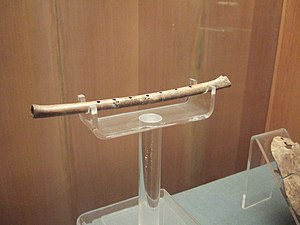
Chinese flutes come in various types. They include
- Dizi (and its varieties such as the qudi and bangdi; primary transverse flutes, usually made of bamboo and distinctively has a buzzing membrane)
- Koudi (a small center-blown mouth flute with open-ends)
- Tuliang (a large center-blown flute with open-ends)
- Chi (an ancient center-blown transverse flute with closed ends and front finger holes.)
- Hengxiao (dizi without membrane)
- Xindi (fully chromatic dizi without membrane)
- Jiajian Di (keyed dizi without membrane)[citation needed]
- Xiao (end-blown vertical bamboo flute)
- Gudi, an ancient vertical flute made from the bones of large birds
- Paixiao (pan pipes with distinctive notched or curved blowholes to allow for greater expression)
- Xun (clay globular flute)
(Uyghur and Mongolian minorities also play a version of the Turkish ney.)
Fipple flutes:
- Jiexiao "Sister xiao" (one of many forms of recorder-style flutes)
- Dongdi (special recorder-style flute with additional internal reed)
- Paidi (fipple pipes)
- Taodi and Wudu (Chinese ocarina.)
Free reed flutes:
- Bawu (transverse free-reed flute)
- Hulusi (vertical gourd free-reed flute normally with one or two drone pipes)
Chinese flutes are generally made from bamboo (see bamboo flutes) and belong to the bamboo classification of Chinese music, although they can be (and have been) made of other materials such as jade.[1][2][3][4]
- ^ "Chinese flutes". oldflutes.com. Retrieved 15 February 2014.
- ^ "The Dizi". 2measures.com. Archived from the original on 28 November 2016. Retrieved 15 February 2014.
- ^ "Chinese flutes and their music" (PDF). gim.ntu.edu.tw. Archived from the original (PDF) on 22 February 2014. Retrieved 15 February 2014.
- ^ "Xiao - Traditional Chinese vertical end-blown flute". danmoi.com. Archived from the original on 15 February 2014. Retrieved 15 February 2014.